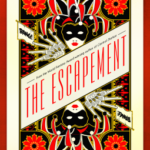Never having read Susanna Clarke’s Jonathan Strange and Mr. Norell, I picked up her Piranesi with no preconceptions about the sort of book it might be and promptly fell in love with it. It’s a masterful fable about life in this world that introduces us to the mind of a narrator who proclaims himself to be one of only two living people in a fantastic labyrinth.
This world, which he calls the House, consists of hundreds of vast connected marble halls lined with strange statues of all sizes and subjects. There is a mythological figure of the faun, half man, half goat, with fingers to its lips as if cautioning silence. There is a giant woman carrying a beehive, a gorilla crouching and leaning forward on its fists, and two enormous figures of horned men straining to emerge from the wall, as if struggling to be born.
The House has a drowned layer covered with tidal waters that provide him with food and fiber for his simple needs, an upper layer of clouds and weather that provides fresh water in the form of rain and a middle layer where he lives and birds abound.
He spends his days carefully observing the hundreds of great halls, cataloguing the statues, recording details of the tides and writing down what he learns in his diary. He considers himself a scientist and completely rational but also capable of wonder at the intricate marvels of the House. As we see through his eyes, this world is one of great beauty and variety.
What are we to make of this man, dressed in threadbare cloths, decorating his hair with seashells and stones, who believes he is describing the entire known world? And is the House really all there is? As I described all this to my partner, she asked a good question: Do you care about the story? I did, but it was hard to say why until I got deeper into it.
The narrator shares the world with one living person, whom he calls the Other, and the skeletons of thirteen dead. For him these are all the people who have ever lived. The Other is a tall, thin, neatly dressed man who is also engaged in researches, but of a very different kind. He believes he can unlock the mysteries of the world and learn a kind of ultimate Knowledge that will give him great power.
Soon enough, the narrator, whom the Other calls Piranesi, loses faith in that search for the Knowledge. One night he comes to a hall lined with statues that are all turned toward an open doorway in which the full moon appears. These statues differ from those in other rooms, which represent individuals of various sorts. These were arranged not in neat tiers but jumbled in a crowd. “Foremost among them was a Young Man, who stood bathed in the Moonlight, elation in his Face, a Banner in his Hand.” (59) He almost forgets to breathe and for a moment imagines what it would be like if, instead of only two people in the world, there were thousands.
It is that experience which brings him the intuitive revelation of the insignificance of the Knowledge the Other searches for. The Other is forever looking for a meaning in the House that he wants to take away, leaving the world behind as mere scenery.
“The sight of the One-Hundred-and-Ninety-Second Western Hall in the Moonlight made me see how ridiculous that is. The House is valuable because it is the House. It is enough in and of Itself. It is not the means to an end.”
Piranesi, Bloomsbury hardcover edition, pp. 60-61
This is the first hint of a deeper conflict between the narrator and the Other. The Other’s name for the narrator, Piranesi, is itself interesting. Piranesi was an eighteenth century Italian artist famous for a fantastical book of etchings called Prisons of the Imagination. Those engravings illustrate Piranesi’s dreams of vast halls full of stairways that go nowhere, complex instruments of torture and always a sense of twisting structures crowding in and confining the tiny human figures depicted in many of them. It’s fitting that the Other would choose that name, suggesting his own view of the vast labyrinthine structure as a puzzle to be solved or a nightmarish place of confinement. For the narrator, this world is a marvel to be grasped as a source of life and respected for its gifts and powers.
Piranesi unfolds as a mystery, as we learn more about the Other, the thirteen skeletons, the narrator and a sixteenth person. The narrator has never seen ’16’, but the Other convinces him this a person of evil to be avoided at all costs.
Since this is a short novel, I can’t give away any more than that except to say that it’s an engrossing, exciting story that draws the reader more and more deeply in with each new diary entry. Through it all the narrator retains the innocence and wonder at the House and all it contains. Piranesi raises profound questions of memory and consciousness, of identity and the way people experience their environment and themselves. For me, it’s one of the genuine masterpieces of recent speculative fiction.





Leave a Reply